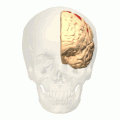Primary motor cortex
Primary Motor Cortex
The Primary Motor Cortex (PMC), also known as M1, is a region in the brain that plays a key role in motor function. It is located in the posterior portion of the frontal lobe, just anterior to the central sulcus. The PMC is responsible for generating neural impulses that control the execution of movement.
Anatomy[edit]
The primary motor cortex is located in the precentral gyrus, and it is the main contributor to generating motor commands. It is bordered by the precentral sulcus anteriorly and the central sulcus posteriorly. The PMC is further divided into an anterior and posterior part. The anterior part is involved in planning and executing movements, while the posterior part is involved in controlling voluntary movements.
Function[edit]
The primary motor cortex is responsible for controlling voluntary movements. It does this by sending signals to the spinal cord, which then sends signals to the muscles. The PMC is organized somatotopically, meaning that specific parts of the PMC control specific parts of the body. This organization is often referred to as the motor homunculus.
Clinical significance[edit]
Damage to the primary motor cortex can result in a variety of motor deficits, including paralysis, apraxia, and motor aphasia. Additionally, conditions such as stroke or traumatic brain injury can also affect the function of the PMC.
Research[edit]
Research on the primary motor cortex has been extensive and has contributed to our understanding of motor control and neuroplasticity. Techniques such as transcranial magnetic stimulation have been used to study the function of the PMC.
See also[edit]

This article is a neuroscience stub. You can help WikiMD by expanding it!
-
Primary motor cortex
-
Diagram of brain sensory and motor areas
-
Animation of Brodmann area 4
-
Human motor map
-
Precentral sulcus
-
Central sulcus
-
Primary motor cortex
Ad. Transform your life with W8MD's Budget GLP-1 injections from $75


W8MD offers a medical weight loss program to lose weight in Philadelphia. Our physician-supervised medical weight loss provides:
- Weight loss injections in NYC (generic and brand names):
- Zepbound / Mounjaro, Wegovy / Ozempic, Saxenda
- Most insurances accepted or discounted self-pay rates. We will obtain insurance prior authorizations if needed.
- Generic GLP1 weight loss injections from $75 for the starting dose.
- Also offer prescription weight loss medications including Phentermine, Qsymia, Diethylpropion, Contrave etc.
NYC weight loss doctor appointmentsNYC weight loss doctor appointments
Start your NYC weight loss journey today at our NYC medical weight loss and Philadelphia medical weight loss clinics.
- Call 718-946-5500 to lose weight in NYC or for medical weight loss in Philadelphia 215-676-2334.
- Tags:NYC medical weight loss, Philadelphia lose weight Zepbound NYC, Budget GLP1 weight loss injections, Wegovy Philadelphia, Wegovy NYC, Philadelphia medical weight loss, Brookly weight loss and Wegovy NYC
|
WikiMD's Wellness Encyclopedia |
| Let Food Be Thy Medicine Medicine Thy Food - Hippocrates |
Medical Disclaimer: WikiMD is not a substitute for professional medical advice. The information on WikiMD is provided as an information resource only, may be incorrect, outdated or misleading, and is not to be used or relied on for any diagnostic or treatment purposes. Please consult your health care provider before making any healthcare decisions or for guidance about a specific medical condition. WikiMD expressly disclaims responsibility, and shall have no liability, for any damages, loss, injury, or liability whatsoever suffered as a result of your reliance on the information contained in this site. By visiting this site you agree to the foregoing terms and conditions, which may from time to time be changed or supplemented by WikiMD. If you do not agree to the foregoing terms and conditions, you should not enter or use this site. See full disclaimer.
Credits:Most images are courtesy of Wikimedia commons, and templates, categories Wikipedia, licensed under CC BY SA or similar.
Translate this page: - East Asian
中文,
日本,
한국어,
South Asian
हिन्दी,
தமிழ்,
తెలుగు,
Urdu,
ಕನ್ನಡ,
Southeast Asian
Indonesian,
Vietnamese,
Thai,
မြန်မာဘာသာ,
বাংলা
European
español,
Deutsch,
français,
Greek,
português do Brasil,
polski,
română,
русский,
Nederlands,
norsk,
svenska,
suomi,
Italian
Middle Eastern & African
عربى,
Turkish,
Persian,
Hebrew,
Afrikaans,
isiZulu,
Kiswahili,
Other
Bulgarian,
Hungarian,
Czech,
Swedish,
മലയാളം,
मराठी,
ਪੰਜਾਬੀ,
ગુજરાતી,
Portuguese,
Ukrainian






